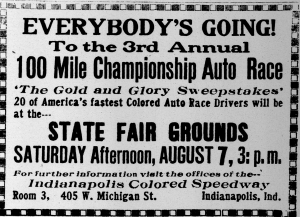Blog Archives
Faith at the Brickyard: Ritual, Fandom, and the Indianapolis 500

Ray Harroun in his Marmon Wasp after winning the first running of the Indianapolis 500 in 1911 (image from Indianapolis Motor Speedway Collection)
Memorial Day weekend is among the most cherished holidays in racing fandom, with the Indianapolis 500 culminating a month of racing and community events. For legions of followers the Indianapolis 500 is an annual rite, and for many fans the journey to the speedway is a pilgrimage to one of racing’s most hallowed spaces. In 1973 the New York Times celebrated the event and place when it intoned that “the 500 is more than a race. It is a folk festival, a happening. Its pageantry, spectacle and corn make it Middle America’s counterpart to France’s pilgrimage to Le Mans.”
The speedway experience involves systematic ritual, intense desire, and visitation to an important place, all of which have some parallels to pilgrims’ religious travel in particular and broader religious experience in general (compare Jean Williams’ 2012 study of pilgrimage to the IMS). Religious characterizations of sport fandom perhaps risk hyperbolizing the consequence of sport, and some observers have ridiculed the hackneyed definition of sports’ “hallowed ground.” In 2008, for instance, sportswriter Andrea Adelson complained that “There is nothing sacred about Augusta National, Yankee Stadium and Wrigley Field. So why are these places referred to in the same way we talk about the Sistine Chapel, St. Patrick’s Cathedral and the Wailing Wall?” Adelson argued that sporting places should be characterized as being “steeped in tradition.” Adelson’s distinction between sacred and secular places reveals a wariness of projecting sacred authenticity onto the prosaic reality of sporting venues, if not sport itself. Read the rest of this entry
Racing Along the Color Line

A July 31, 1926 advertisement in the Indianapolis Recorder for the third running of the Gold and Glory Sweepstakes.
This month the massive crowds at the Indianapolis Motor Speedway appear to confirm its confident claim to being the “motor racing capital of the world.” Racing began on the oval in 1909 and the 500-mile race first ran two years later, with the 99th running of the 500-mile race approaching on Memorial Day weekend. The speedway is a National Historic Landmark, and its fascinating social history reaches well beyond the obsessive statistics and biographical minutia that motorheads have compulsively detailed for a century. The IMS dominates American racing mythology and is as much a pilgrimage destination as a race track. Like so many shrines it invokes a host of American traditions that are perhaps more firmly rooted in our imagination and hagiography than especially concrete history.
The imagination of the speedway’s history has recently begun to contemplate historical racial inequalities in sports. This year the 500 Festival parade before the race will be marshalled by the 1955 state high school basketball champions from Indianapolis’ segregated Crispus Attucks High School. The Attucks champions’ place in the pre-race parade celebrates Indiana’s two most adored sports, basketball and racing, but of course the implications of sport and the color line extend beyond the hardwood and the speedway. No 20th-century Indiana institution escaped anti-Black racism, and the speedway and the Indianapolis 500 was long a segregated space and has included very few people of color on the track or in the pits. The prominence of the Attucks players makes a modest but potentially important concession of racism in sports, though the concrete social effects of such discussions remain to be evaluated. Read the rest of this entry

